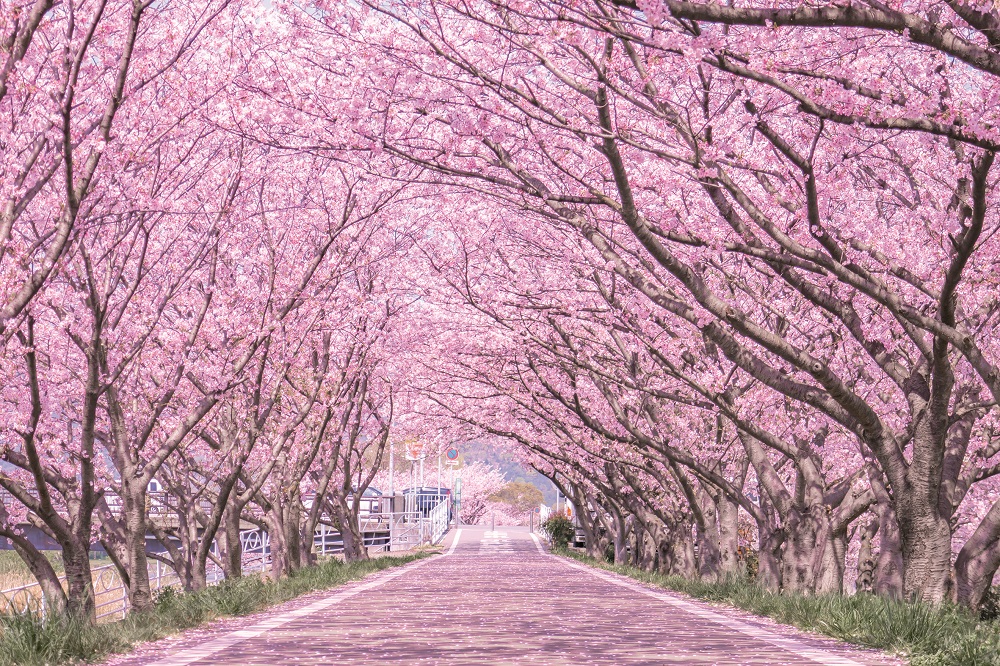Often associated with sweetness, love, and femininity, pink has a rich and varied history spanning art, literature, nature, cinema, and mass culture. In this article, we explore the origins of this colour, its meaning, and the ways in which it has been used over the centuries.
As a colour rich in history and symbolism, pink has gone through centuries of cultural and artistic transformation, eventually finding a significant role in film, fashion, and psychology. Rare and precious in ancient times, pink underwent a profound evolution from the Renaissance to the 18th century, becoming a symbol of elegance and power thanks to figures such as Madame de Pompadour. In the 20th century, it took on connotations of femininity and delicacy, although it was also considered a masculine colour in the past. In psychology, pink is associated with tranquillity, compassion, optimism, and creativity and is thought to have a calming power and positive impact on our state of mind. From iconic films like “Breakfast at Tiffany’s” and “Mean Girls” to pop culture and awareness campaigns like the “Pink Ribbon” one, this hue continues to influence and inspire, remaining central in today’s cultural and social trends.
Pink in history
Obtained by mixing red with white, pink has gone through centuries of cultural and artistic transformation. In ancient times, it was difficult to obtain and, therefore, rare and precious. The first use of this colour in art can be traced back to ancient Rome, where it was utilised for frescoes and ceramic decorations. As the centuries progressed, during the Renaissance, pink became more accessible thanks to advances in pigment production and was used in religious paintings to depict human skin and sacred garments.
The word “pink” first appeared in the 17th century, but the colour only spread widely in the 18th century. It was in this period that Madame de Pompadour, King Louis XV’s mistress, was known for elevating pink to a symbol of fashion and prestige, so much so that La Manufacture Nationale de Sèvres, one of the most famous porcelain manufacturers in Europe founded in 1740 in Sèvres (France), christened a shade of pink porcelain “Pompadour Pink” by order of the sovereign himself.
At that time, pink was worn by women and men alike and considered an elegant and powerful tint. However, its meaning has changed over time. In the West, it is now traditionally associated with femininity, sweetness, and innocence, a connotation that was consolidated in the 20th century. Before the 19th century, pink was actually often considered a masculine colour, especially for children. In many Asian cultures, pink symbolises good luck and happiness. Today, this colour is also associated with tranquillity and serenity. Psychological studies have shown that it can have a calming effect and reduce levels of aggressiveness – which is why it is used in environments such as hospitals, prisons, and schools to provide a serene atmosphere.
The origin of the word “pink”
In English, before the end of the 16th century, this hue was called “incarnation”, with the meaning of “flesh colour”. It then began to be called “pink” from the common name of a garden plant with flowers in this colour, called dianthus – although earlier, this word indicated a greenish yellow. To further complicate the matter, the origin of this word is unknown. Some etymologists suggest it was taken from an earlier verb that means “to wink,” as some pinks look like the irises of eyes. Other sources indicate that it was derived from a different verb “pink” that means “to perforate in an ornamental pattern,” referring to the jagged edges of most pinks. Or, perhaps, it was from Dutch pink
meaning “small” or “narrow,” itself obscure.
In Italian (and similarly in other European languages), the name and adjective rosa
is linked to another flower, the rose. This plant had considerable symbolic and cultural importance in ancient civilisations, which led the term to spread widely. In many of these cultures, the rose has been associated with love, beauty, and passion, and these connotations have also been reflected in language. For example, in Greek mythology, it was associated with Aphrodite, the goddess of love, and in Roman times, with Venus.
Pink in literature and art
The colour pink has played a significant role in both literature and art, taking on different meanings and connotations depending on the historical and cultural context. In literature, it is traditionally associated with delicacy and sensitivity. For example, in many of Jane Austen’s works, female characters are often described in pink dresses, symbolising purity and romance. However, the meaning of pink has never been static: in the novel “Bad Girls” by Joyce Carol Oates, for instance, this colour is used to represent rebellion and inner strength, being associated with strong and independent female characters.
Pink has undergone significant transformations in art as well. During the Rococo period, it represented elegance and refinement, as shown in the works of François Boucher and Jean-Honoré Fragonard. In the 20th century, artists like Pablo Picasso and Mark Rothko employed pink innovatively to explore emotion and introspection. Picasso, in particular, went through a “Pink Period” in which his works expressed serenity and warmth. In Postmodernism, artists such as Jeff Koons have used pink to explore mass culture and kitsch, often to comment on the commercialisation of beauty and the superficiality of popular culture.
Pink in nature
Pink can be found in nature in many forms, from flowers to landscapes. One of the most famous examples is Japan’s cherry blossoms, or sakura. These flowers colour landscapes with delicate pink tints and take on deep cultural meanings. Celebrated during Hanami, their blossoming symbolises the ephemeral beauty of life and the importance of appreciating fleeting moments.
 Cherry blossom season in Japan. © AdobeStock
Cherry blossom season in Japan. © AdobeStockOn the other hand, flamingos are famous for their bright pink plumage due to their diet. Contrary to what one might think, these birds are not born pink but with grey or white feathers. During their lives, they acquire this colour by eating crustaceans and algae rich in carotenoids: these organic pigments, once digested, are metabolised and deposited in their feathers, beak, and skin. The pink colour thus becomes a visual indicator of a flamingo’s health and diet: the richer the diet in carotenoids, the brighter the plumage.
Finally, nature offers us some beautiful landscapes in various nuances of this colour. Described as the “Caribbean of the Mediterranean” and located on the southwestern coast of Crete, Elafonissi Beach is one of Greece’s most popular summer destinations; it is also world-famous for its pink sand, formed by pink and red foraminifera and shells that pulverise on contact with seawater. The pink beach of Budelli, located in the La Maddalena archipelago in Sardinia (Italy), is also well known for its pink sand, composed of calcareous shells of a unicellular organism, Miniacina miniacea, and fragments of coral.
 The famous pink beach of Budelli, Sardinia. © AdobeStock
The famous pink beach of Budelli, Sardinia. © AdobeStockPink-mania
Pink has had a crucial impact on cinema and mass culture, evoking specific atmospheres and setting characters apart as symbols of elegance, rebellion, and power. This shade has found ample space in numerous iconic films and has left a significant imprint on fashion and social trends.
In the film “Breakfast at Tiffany’s”, pink emphasises the elegance, vivacity, sophistication, and glamour of Holly Golightly, the famous character played by Audrey Hepburn. Similarly, in “Grease”, the “Pink Ladies” group adopts pink as a symbol of friendship and teenage rebellion, creating an enduring icon of 1970s fashion and pop culture. Pink continued to be a distinctive colour in popular culture with films like “Mean Girls”, where the famous line “On Wednesdays we wear pink” became a symbol of conformity and belonging to a social group. Such use of pink to represent power and social dynamics among teenagers has consolidated its role in youth culture.
At the same time, besides cinema, pink is deeply rooted in contemporary mass culture. It is the distinctive colour of many brands and products, including the iconic Italian Big Babol chewing gum, the Victoria’s Secret logo, and Barbie’s packaging. Launched in 1959 by Mattel, Barbie initially did not have pink as her predominant colour. However, in the 1960s and 1970s, this emerged as a key element in the branding of the world’s most famous doll, reinforced in the 1980s and 1990s through targeted marketing strategies. Today, Barbie Pink has become an iconic and ubiquitous symbol in pop culture, giving the brand and those who wear this tint a strong sense of femininity and glamour.
 The Barbie brand has made pink its dominant colour. © AdobeStock
The Barbie brand has made pink its dominant colour. © AdobeStockSuch success was further amplified by the movie Barbie, directed by Greta Gerwig and starring Margot Robbie and Ryan Gosling, which was a resounding success at the box office, grossing over 1.4 billion dollars globally and becoming one of the biggest cinematic successes of 2023 as well as the highest-grossing film ever produced by Warner Bros. This movie not only made Barbie fashionable again but also demonstrated cinema’s ability to affect cultural and commercial trends. The dominant bright pink of the setting and costumes awakened and amplified the appeal of this colour, leading to a renewed interest in using this shade in fashion and decoration. An example of this is the powder-pink Arizona sandals produced by German company Birkenstock: according to the online shopping platform Lyst, only one week after the film’s release, online searches for pink Birkenstocks increased by 110%. The representation of Barbie’s world has fuelled a wave of nostalgia and stimulated a debate on femininity and gender identity-related topics, suggesting that pink will continue to be a central element in pop culture.
However, pink is also linked to more serious and important issues that usually revolve around women. The “Pink Ribbon”, the international symbol of the fight against breast cancer, is much more than just a pink ribbon. It represents solidarity and hope for millions of people worldwide, helping raise awareness and funds for research and treatment of this oncologic condition. Finally, pink has also been finding significant application in social and political movements. The “Pink Protest”, for example, is an initiative that uses colour to support women’s and minority rights, proving that pink can also be a powerful tool for advocacy and activism.